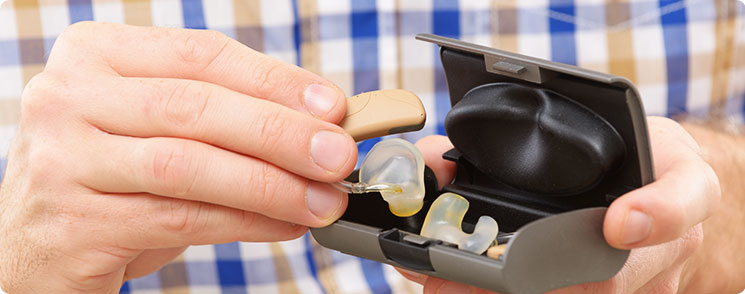Earmolds are all around us. We see them everyday, whether we recognize them or not. Newscasters, reporters, talk show hosts, film and broadcast crews, race car drivers and their pit crews, pilots, law enforcement agents, construction workers, hunters, and farmers, for example, all use various types of earmolds. Some need them to protect their hearing, while others use earmolds to channel and amplify sound. The most familiar use of an earmold would probably be for a hearing aid. In this article, we will discuss the most common types of earmolds, what their applications are, and how to best maintain them. After completing this article, the reader should be more familiar with earmolds and their basic maintenance.
What is an earmold?
An earmold is a custom made in-the-ear device that will have a specific function, depending on what the wearer’s needs are. The most common uses are for either amplifying sound, or protecting against it. The device itself is usually inanimate; no power source or controls are installed. If one were to observe it, it would look like a small plug that fits exactly into the wearer’s ear canal.
Why do earmolds have different shapes and sizes?
The size and shape of an earmold will vary, depending on several factors: anatomy of wearer’s ear canal, what the function of the earmold will be, and how tightly the earmold will need to seal the wearer’s ear canal. Every person has a uniquely shaped ear, and thus the shape of the customized earmold will need to match that of the wearer’s ear, so it may fit into the ear canal comfortably and securely. Regarding function and size of the earmold, protective devices that reduce sound tend to be larger, and will fill most of the lower external ear, which is comprised of the anterior portion of the external auditory meatus, the entire concha region, and most of the cymba region. There usually isn’t much variation from this design because the goal of a protective earmold is to create a tight acoustic seal for the wearer, thus protecting them from damaging levels of noise. Earmolds that are designed to channel sound from a hearing aid, however, will always have a much greater variety of sizes and form factors, because they do not always require a complete acoustic seal of the ear. These earmolds can just fill the anterior portion of the external auditory meatus, for example, thus leaving the rest of the ear open. A general rule for hearing aid earmolds follows that their size will depend on the power level of the hearing aid it is attached to. As the power levels of hearing aids increase, so too will the size of the earmolds they will use.
What is an earmold made of?
The materials used to build an earmold are confined to soft types, which are silicone and vinyl, and hard types, which are lucite and acrylic. Some earmold manufacturers have a proprietary blend of several of these materials. Softer materials materials are employed when the earmold is used to protect hearing, or when the wearer is bothered by hard materials in their ear. Harder materials are used for durability and dexterity concerns. Soft, easily damaged external ear tissue of the wearer, and allergies to silicone are other reasons soft earmolds will not be considered.
How does an earmold work?
As mentioned earlier, earmolds have various styles and purposes, depending on the user’s needs. When an earmold is intended to protect the user’s hearing, the mold will seal the ear canal and prevent harmful levels of noise from going into the ear and causing damage. Earmolds that amplify sound will seal the user’s ear canal, and channel sound from a hearing aid, or other amplified device, directly into the patient’s ear. The use of custom earmolds are indicated when a user needs to hear a signal, in their ear, without outside noise interfering. Pilots, law enforcement, musicians, broadcasters, and hearing aid wearers all use various types of these earmolds.
Infection control of earmolds

A clear danger to every person who uses an earmold is developing an infection resulting from exposure to contaminants originating from their product(s). In fact, “contact transmission remains the most common means of cross-contamination and possible disease transmission” (Kemp & Bankaitis, 2000). Preventing disease transmission is vital to the successful use of an earmold. Preventing contaminants from proliferating on the surface of an earmold requires more than simply cleaning the surface of the device. Rather, it involves a multi-factored approach. The wearer of an earmold must not only clean their earmold, but must also disinfect their earmold daily, in order to prevent disease transmission and resulting infections “environmental infection control requires cleaning, disinfecting, and sterylization” (Clark, Kemp, & Bankaitis, 2003). Hearing aid wearers are only concerned with cleaning and disinfecting earmolds, as sterylizing is indicated when “an object is contaminated with a potentially infectious material, such as blood, mucous, or other bodily fluids or substance” (Clark, Kemp & Bankaitis, 2003). Cleaning an earmold Cleaning a user’s earmold involves simply removing gross contamination from the device’s surface area. No germs are removed during the cleaning process. Common materials and tools employed to clean earmolds are dry tissues, dry paper towels, cleaning brushes, and wire loops. Disinfecting an earmold When an earmold is disinfected, all contamination and germs are removed from the device. The materials used to disinfect an earmold usually consist of moist non-alcohol based disinfectant surface wipes, or a spray of the same type of solution. Sterylizing earmolds As mentioned previously, sterylizing an earmold is only indicated when it has been exposed to contaminated bodily fluids, such as blood or mucus. The user should bring an earmold in that condition to their hearing aid specialist, who will detach the earmold from the sound device it is coupled with and will submerge it in a bath of a germicide solution for an extended period.
Storage and care of earmolds
Do Not
- Place an earmold on surfaces where bacteria and fungi proliferate, i.e. counter tops, desks, purses, pockets, etc.
- Store an earmold in a container that cannot be washed out with soap and water, such as a jewelry box, small cardboard box, or paper envelope.
- Allow people to handle an earmold if they do not understand how to disinfect it after they have touched it.
Do
- Store earmolds in washable containers (plastic). Modern earmolds typically come supplied with washable containers.
- Clean and disinfect earmolds every day, or at least when they are worn.
Learn more about hearing aids and how TruHearing can help you with your hearing aid journey.
Works Cited
- Bankaitis, A.U. & Kemp, R.J. (2002). Hearing Aid Infection Control. In: M. Valente (Ed) Strategies for Selecting and Verifying Hearing Aid Fittings, 2nd edition (pp. 369-383). Theime Publishing Group, New York, New York.
- Kemp, R.J. & Bankaitis, A.E. (2000). Infection Control for the Audiologist. In: H. Dunn, R. Roeser, and M. Valente (Eds). Handbook of Audiology: Practice Management (pp. 257-272). Theime Publishing, New York, New York.
- J.G. Clark, R.J. Kemp, & A.U. Bankaitis. (2003). Infection Control in Audiological Practice. Audiology Today, v 15:5.

